If you’re torn between two giant-hearted breeds, the Great Dane vs Rottweiler debate is a big one—literally! Both are powerful, impressive dogs with strong personalities and even stronger bonds with their humans. The Great Dane, often called the “Apollo of dogs,” is a towering, gentle giant originally bred in Germany for hunting wild boars and protection work.
Despite their size, these pups are known for their sweet, easygoing nature and goofy charm. On the other side, we have the Rottweiler—a sturdy, confident protector with ancient Roman roots. With their muscular build, fierce loyalty, and affectionate side, Rotties have long been a favorite among families.
Though they’re both large, their energy levels, temperaments, and care needs are quite different. If you’re trying to decide between the tall and elegant Great Dane or the powerful and loyal Rottweiler, we’ve got you covered. Let’s dive into the main differences to help you find your perfect canine match!
Great Dane vs. Rottweiler
The Great Dane is an elegant giant originally bred for boar hunting. Known for its towering height, square-jawed head, and graceful build, the Great Dane stands out as the tallest of all working breeds. Despite its size and hunting history, this breed is celebrated for its gentle temperament, dependability, and friendly nature.
Its short coat comes in various colors, including fawn, brindle, black, blue-gray, harlequin, and mantle. Though often mistaken as Danish due to its name, the breed has no true ties to Denmark—in Germany, it’s more fittingly known as the Deutsche Dogge.
The Rottweiler, on the other hand, has a rugged past as a Roman Drover Dog, for they were used for driving cattle. Later, it became a trusted companion in the German town of Rottweiler. Known as the “Butcher’s Dog,” Rottweilers once herded livestock and protected merchants, even carrying money in neck pouches, states Britannica.
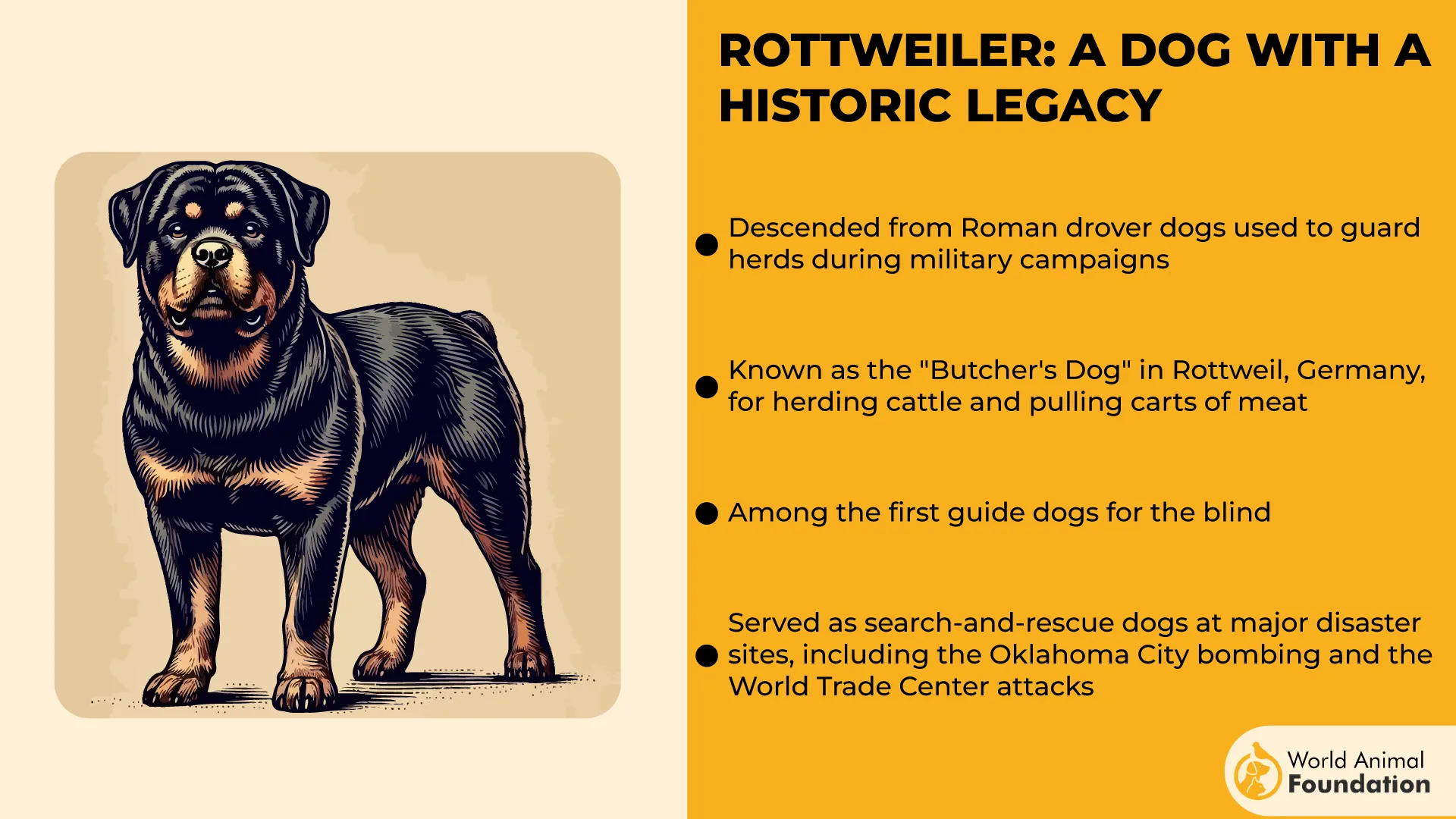
Their strong, muscular frame and deep sense of loyalty made them excellent guardians. While their original working role diminished with the rise of rail transport, Rottweilers adapted to new jobs in police, military forces, guard dogs, and even therapy work. In contrast to the Great Dane’s regal elegance, the Rottweiler brings a powerful, protective presence, making both breeds unique in their strengths and appeal.
Breed Origins: Rottweiler vs. Great Dane
The Great Dane has deep roots in Germany, where it was developed over 400 years ago as a fearless boar-hunting dog for nobility. Despite its misleading name—borrowed from the French term Grand Danois or “Big Danish”—the breed has no ties to Denmark and is known in its homeland as the Deutsche Dogge or “German Mastiff.”
Originally prized for their strength and bravery in the hunt, these towering canines eventually transitioned into devoted protectors of homes and families. Their noble lineage and elegant appearance earned them admiration both for function and form.
In contrast, the Rottweiler traces its lineage back to the Roman Empire, descending from the Molossus, a mastiff-type dog that accompanied Roman legions as they conquered Europe. These powerful dogs helped drive and protect cattle during the army’s travels, and as they passed through what is now Germany, they bred with local dogs, laying the groundwork for the Rottweiler breed.
Named after the town of Rottweil, they served as butcher’s dogs and guardians. Officially recognized by the American Kennel Club in 1931, Rottweilers grew in popularity during the 1990s and continue to serve today in roles ranging from police dogs and military work to excellent family pets.
Physical Appearance Comparison
The Great Dane is renowned for its towering height and graceful build, often referred to as a “gentle giant.” The Great Dane’s average height is between 28 and 32 inches tall—sometimes even taller—and these big dogs can weigh anywhere from 110 to 175 pounds. Some, like the famous Zeus, have reached up to 41 inches at the shoulder.
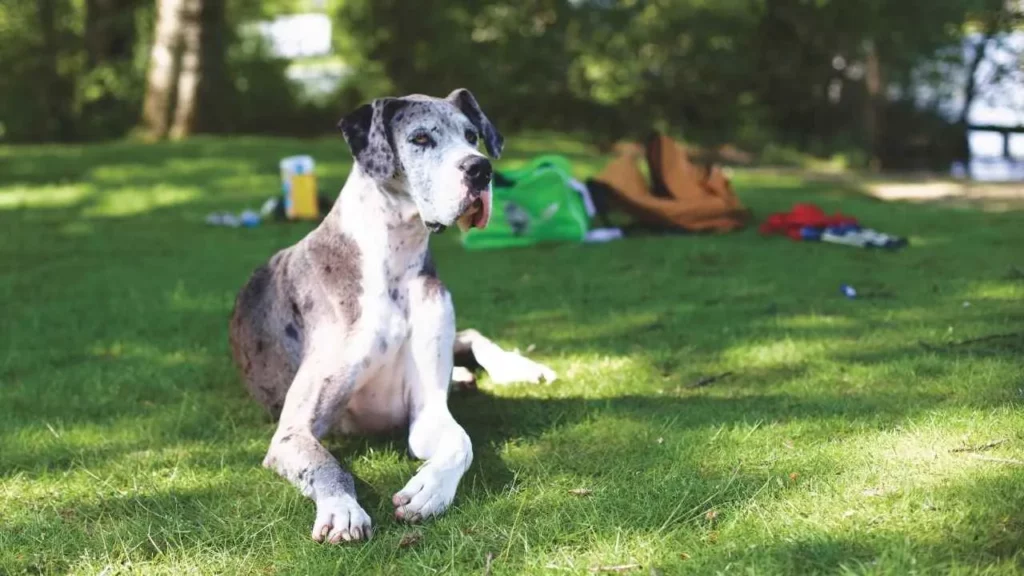
Great Danes grow rapidly during their first year, gaining size comparable to a 14-year growth in humans. Their short coat comes in a variety of colors, including black, white, harlequin (with irregular black patches), blue, merle, and fawn, with each pattern adding to the breed’s striking presence.
The Rottweiler, while shorter than the Great Dane, has a more compact and muscular frame. Males typically stand 24 to 27 inches tall and weigh 110 to 130 pounds, while females are slightly smaller. Their defining physical features include a shiny black coat with distinct rust-colored or tan markings above the eyes, on the muzzle, chest, and legs, according to WebMD.
These signature “eyebrow” spots and powerful, stocky build give Rottweilers a bold, confident appearance, reinforced by their notably strong bite and robust physique.
Social and Behavioral Differences
The Great Dane is often described as a gentle giant, calm, affectionate, and generally friendly toward both family members and strangers. While they aren’t overly energetic, they do enjoy moderate play and require daily walks to stay physically and mentally balanced. Early socialization is crucial for this breed, as poorly socialized Great Danes can become timid or anxious in unfamiliar settings.
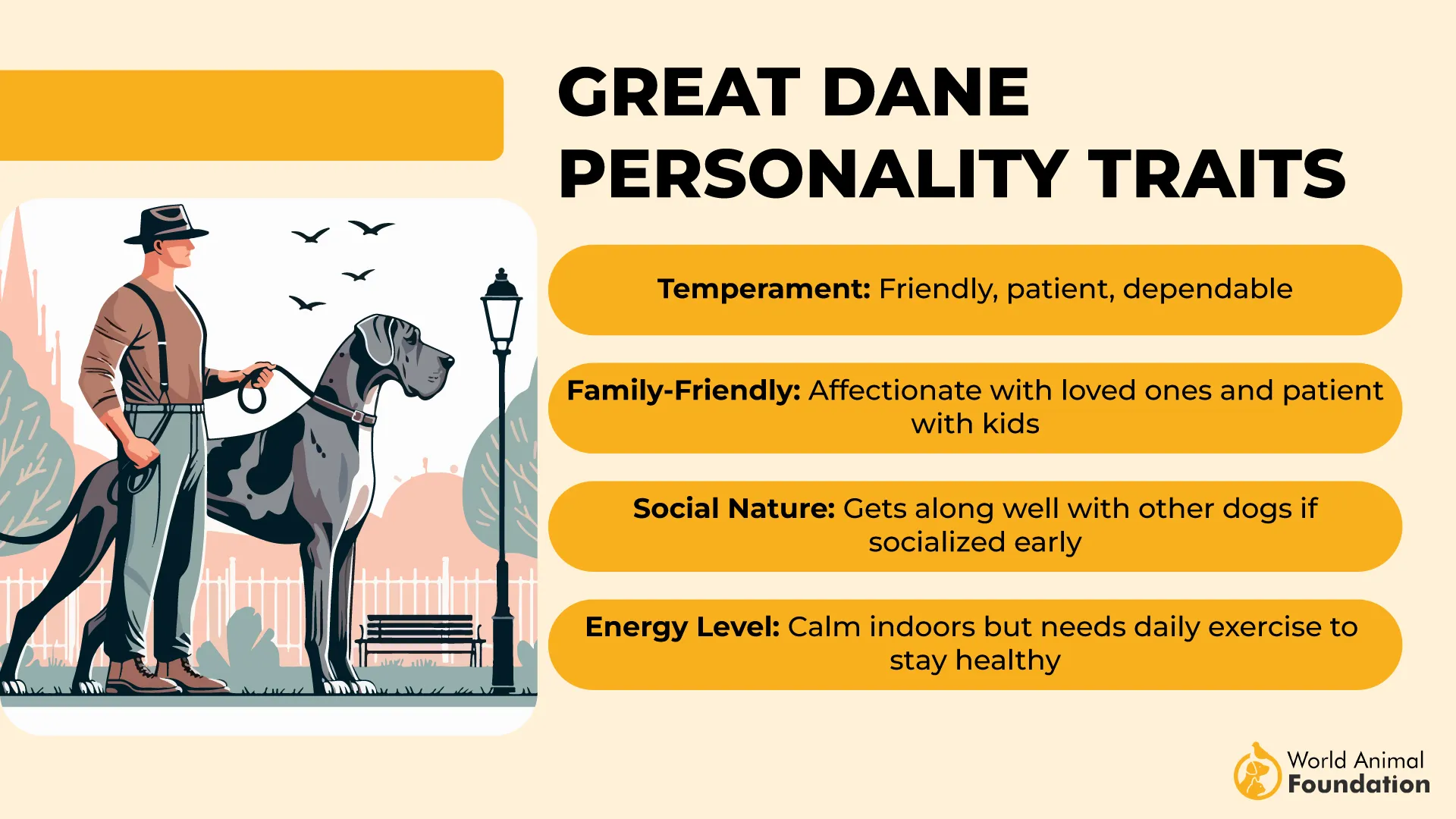
With proper training and exposure to new environments, they become well-mannered, confident companions. Despite their intimidating size, they are not an aggressive breed and rarely bark without cause, making them peaceful housemates for families with the space and strength to manage them.
In contrast, Rottweilers are natural guardians with strong protective instincts, which can make them wary in unfamiliar situations. Their temperament can vary—from playful and affectionate to more serious and reserved—but most Rottweilers are loyal, calm, and deeply attached to their people.
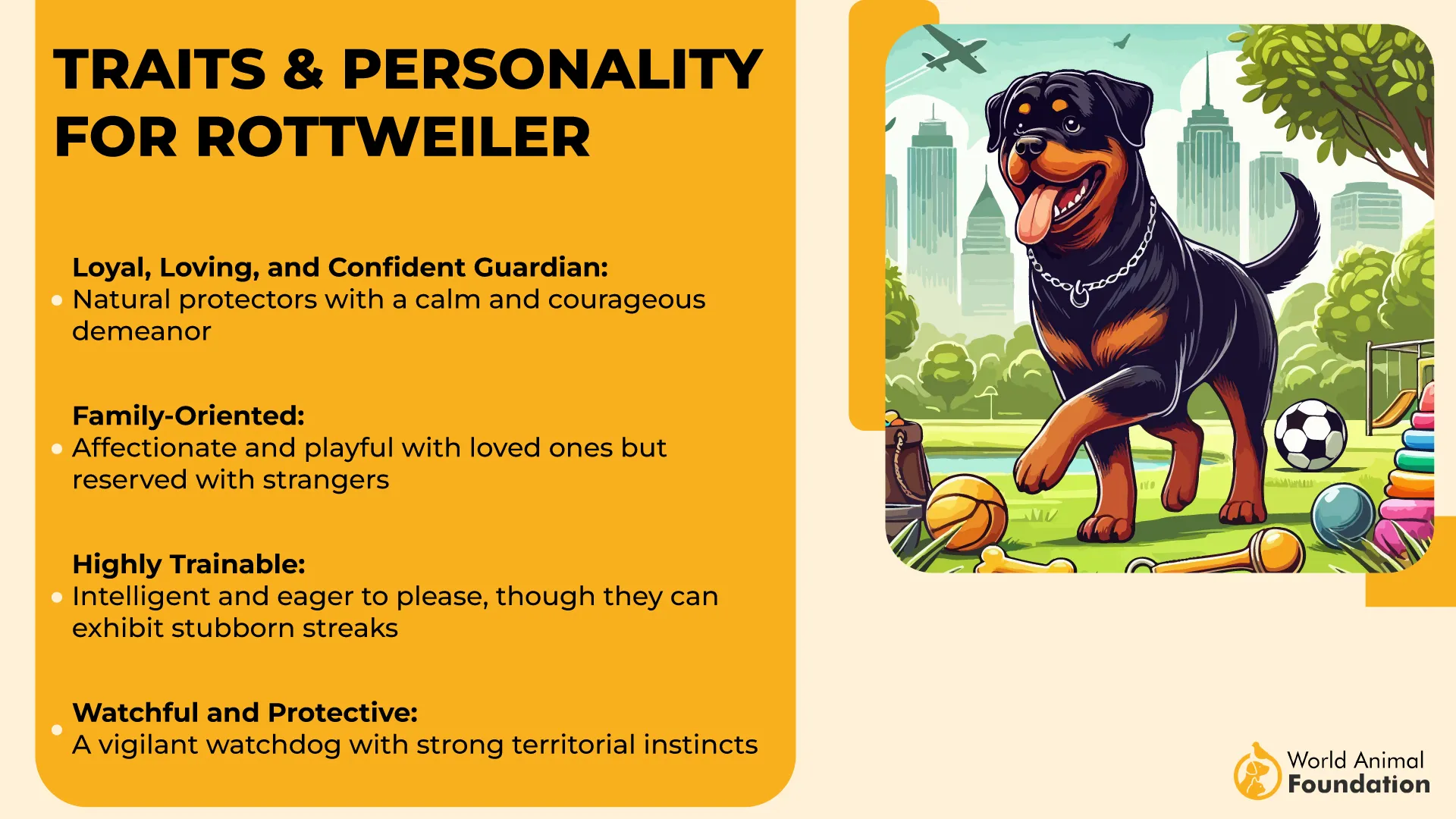
Because of their strength and intelligence, they require structured socialization and mental stimulation from an early age. Without it, they may develop behavioral issues like excessive barking or destructive chewing when bored. While not prone to unnecessary barking, their protective nature means they’re alert and responsive to potential threats, making them excellent watchdogs with a dependable, work-focused personality.
Health and Wellness Comparison
When it comes to lifespan and overall well-being, Great Danes have relatively short lifespans, typically living between 7 to 10 years. Their large size contributes to several health problems, the most serious being gastric dilatation-volvulus (GDV), a life-threatening bloat condition that may require emergency surgery. Many owners choose preventative gastropexy surgery to reduce this risk.
Britannica states that dilated Cardiomyopathy is another common concern, and due to rapid growth, Great Dane puppies need large-breed-specific food to minimize the risk of hip dysplasia and mobility issues. Regular vet visits, balanced diet, careful meal management—like feeding smaller, spaced-out portions—are crucial for maintaining their health and avoiding these major complications. Regular ear cleaning and dental care are also part of grooming needs.
Rottweilers, with a slightly longer average lifespan of 9 to 10 years, face their own set of health concerns. They are particularly prone to obesity, which can worsen conditions like hip joint and elbow dysplasia, CCL ruptures, and heart issues such as subaortic stenosis. Rottweilers are also genetically predisposed to aggressive bone cancer (osteosarcoma), states PetMD.
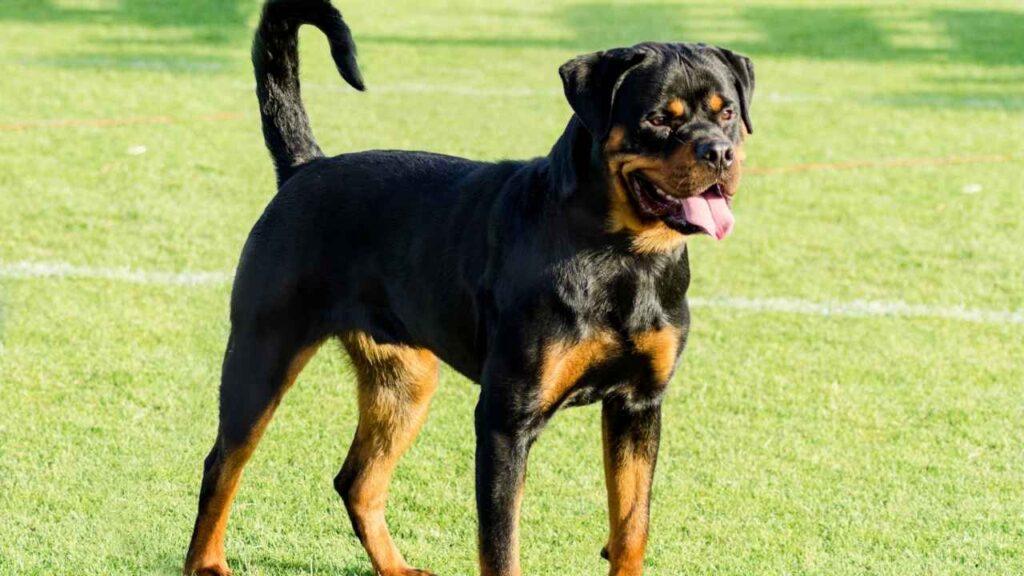
Preventative care, such as maintaining a healthy weight, providing low-impact exercise, and regular vet checkups, is key to keeping them healthy. Early detection of symptoms and proper treatment—ranging from orthopedic surgery to joint supplements—can greatly improve a Rottweiler’s quality of life.
The Rottweiler–Great Dane Mix Explained
The Rottweiler–Great Dane mix, commonly known as the Weiler Dane, is a powerful hybrid that combines the strength and loyalty of its parent breeds. With the towering height of the Great Dane and the muscular build of the Rottweiler, Weiler Danes are both imposing and affectionate.
Weiler Dane often features a mix of black and brown coloring, with a signature black mask and floppy ears that hang close to the cheeks. Typically, they stand between 28 and 30 inches tall and weigh 130 to 155 pounds, making them slightly larger than Rottweilers but a bit smaller than the tallest Great Danes.
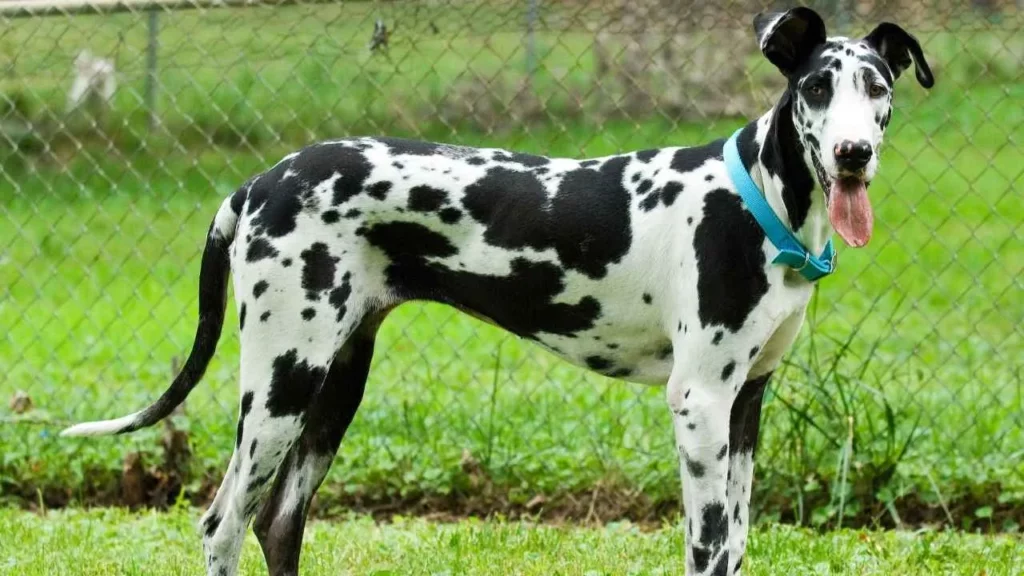
Bred from two historically protective working dog breeds, the Weiler Dane naturally inherits strong guarding instincts, intelligence, and a calm yet alert demeanor. They form deep bonds with their families, including children and other pets, although supervision is advised due to their large size and playful energy.
These dogs thrive on mental stimulation and physical activity, making dog sports like weight pulling, obedience, or scent work excellent outlets for their energy. With the right training and proper socialization, the Weiler Dane is a devoted, affectionate companion and a steadfast protector of home and family.
Which Breed Is Right for You?
Choosing between a Great Dane and a Rottweiler largely depends on your lifestyle, home space, and experience with large breeds. Great Danes are gentle giants with a calm, affectionate nature and lower energy levels, making them ideal for families seeking a laid-back companion.
They are generally good with small children when properly socialized from a young age and are also pet-friendly. However, their massive size, short lifespan (7–10 years), and risk of serious health issues like bloat and cardiomyopathy mean they require vigilant care and ample living space.
Rottweilers, on the other hand, are strong, intelligent dogs, incredibly loyal and protective—better suited for experienced owners who can offer consistent training sessions and early socialization. They bond closely with their families and have a natural guarding instinct, making them excellent watchdogs.
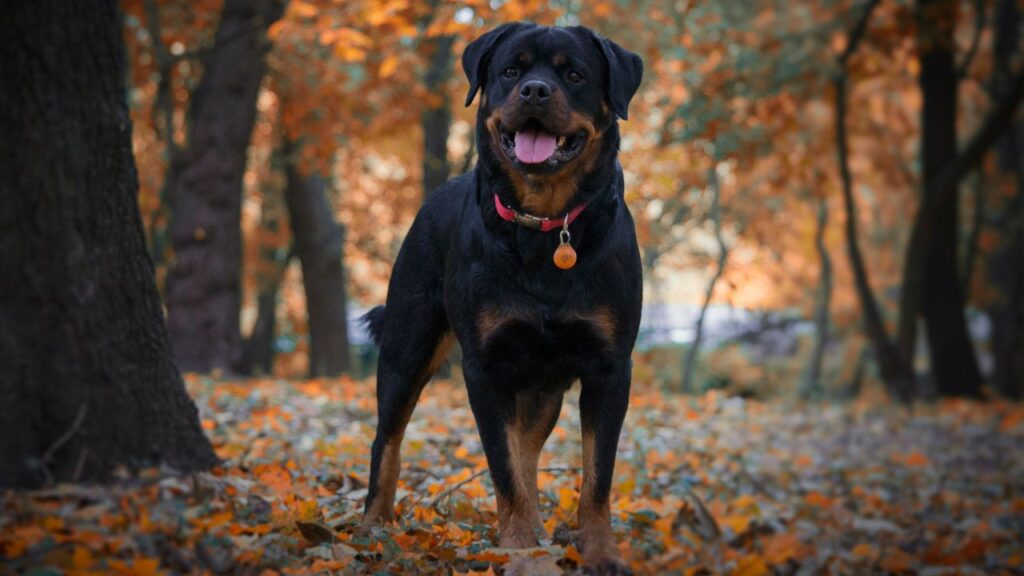
While Rottweilers can be affectionate and even goofy, they tend to be more serious-minded as adults and need at least an hour of daily exercise to avoid boredom and behavioral issues. With a slightly longer lifespan and fewer structural health risks than Great Danes, Rottweilers are a ideal companions for active homes committed to training and engagement.
Conclusion
In conclusion, the Great Dane and Rottweiler are two distinct breeds, each with distinct personalities and traits that make them great pets for the right owner. Both breeds require early socialization to develop into well-mannered dogs, especially given their size and protective instincts.
While Great Danes are naturally inclined to be gentle giants with moderate exercise needs and minimal shedding that suit day grooming routines, Rottweilers are strong, driving dogs that benefit from more rigorous physical activity and mental stimulation.
Owners should be mindful of health concerns like hip and elbow dysplasia, common in both breeds and many other dogs, and consider their living situation carefully. Great Danes may struggle with apartment living due to their size. At the same time, Rottweilers might adapt better with proper training.
Understanding the breed standard and their care requirements helps minimize challenges during extended periods of ownership. Whether you choose one breed or are fascinated by both, these dogs offer loyal companionship that stands out among other breeds.


